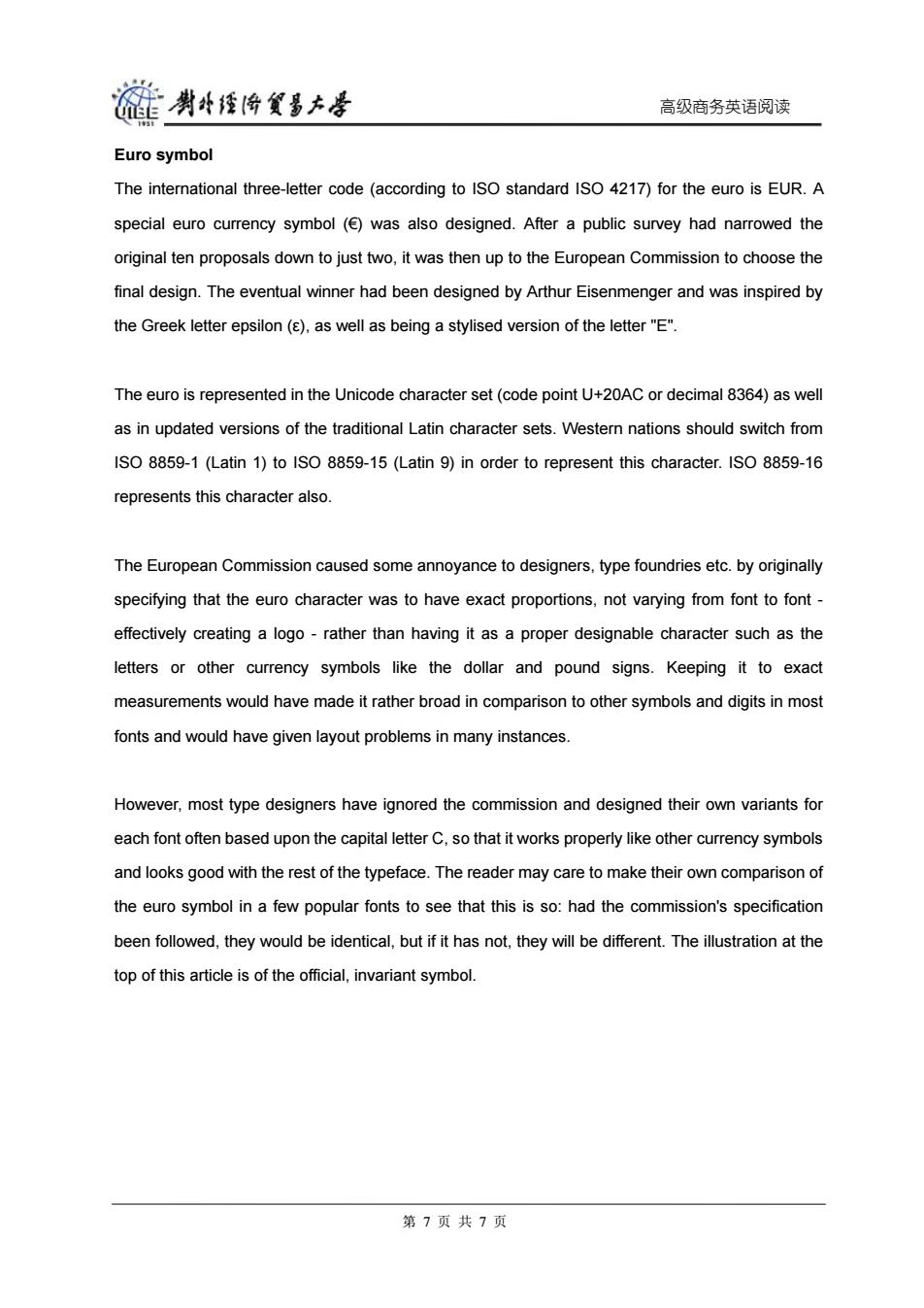正在加载图片...

链剥挂将发多大是 高级商务英语阅读 Euro symbol The international three-letter code (according to ISO standard ISO 4217)for the euro is EUR.A special euro currency symbol (E)was also designed.After a public survey had narrowed the original ten proposals down to just two,it was then up to the European Commission to choose the final design.The eventual winner had been designed by Arthur Eisenmenger and was inspired by the Greek letter epsilon(),as well as being a stylised version of the letter"E". The euro is represented in the Unicode character set(code point U+20AC or decimal 8364)as well as in updated versions of the traditional Latin character sets.Western nations should switch from ISO 8859-1 (Latin 1)to ISO 8859-15(Latin 9)in order to represent this character.ISO 8859-16 represents this character also. The European Commission caused some annoyance to designers,type foundries etc.by originally specifying that the euro character was to have exact proportions,not varying from font to font- effectively creating a logo-rather than having it as a proper designable character such as the letters or other currency symbols like the dollar and pound signs.Keeping it to exact measurements would have made it rather broad in comparison to other symbols and digits in most fonts and would have given layout problems in many instances. However,most type designers have ignored the commission and designed their own variants for each font often based upon the capital letter C,so that it works properly like other currency symbols and looks good with the rest of the typeface.The reader may care to make their own comparison of the euro symbol in a few popular fonts to see that this is so:had the commission's specification been followed,they would be identical,but if it has not,they will be different.The illustration at the top of this article is of the official,invariant symbol. 第7页共7页高级商务英语阅读 Euro symbol The international three-letter code (according to ISO standard ISO 4217) for the euro is EUR. A special euro currency symbol (€) was also designed. After a public survey had narrowed the original ten proposals down to just two, it was then up to the European Commission to choose the final design. The eventual winner had been designed by Arthur Eisenmenger and was inspired by the Greek letter epsilon (ε), as well as being a stylised version of the letter "E". The euro is represented in the Unicode character set (code point U+20AC or decimal 8364) as well as in updated versions of the traditional Latin character sets. Western nations should switch from ISO 8859-1 (Latin 1) to ISO 8859-15 (Latin 9) in order to represent this character. ISO 8859-16 represents this character also. The European Commission caused some annoyance to designers, type foundries etc. by originally specifying that the euro character was to have exact proportions, not varying from font to font - effectively creating a logo - rather than having it as a proper designable character such as the letters or other currency symbols like the dollar and pound signs. Keeping it to exact measurements would have made it rather broad in comparison to other symbols and digits in most fonts and would have given layout problems in many instances. However, most type designers have ignored the commission and designed their own variants for each font often based upon the capital letter C, so that it works properly like other currency symbols and looks good with the rest of the typeface. The reader may care to make their own comparison of the euro symbol in a few popular fonts to see that this is so: had the commission's specification been followed, they would be identical, but if it has not, they will be different. The illustration at the top of this article is of the official, invariant symbol. 第 7 页 共 7 页